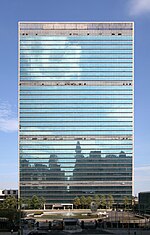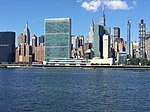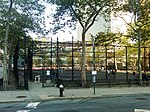Single Form

Single Form (BH 325) is a monumental bronze sculpture by the British artist Barbara Hepworth. It is her largest work, and one of her most prominent public commissions, displayed since 1964 in a circular water feature that forms a traffic island at the Headquarters of the United Nations in New York City, outside the United Nations Secretariat Building and the Dag Hammarskjöld Library. It is also the largest artwork cast by the Morris Singer foundry. Copies of a smaller version, Single Form (Memorial) (BH 314), are on public display outside the Johns Hopkins University's Paul H. Nitze School of Advanced International Studies in Washington, D.C. and in Battersea Park in London. The version in Battersea Park was granted a Grade II* listing in January 2016.
Excerpt from the Wikipedia article Single Form (License: CC BY-SA 3.0, Authors, Images).Single Form
East 42nd Street, New York Manhattan
Geographical coordinates (GPS) Address Nearby Places Show on map
Geographical coordinates (GPS)
| Latitude | Longitude |
|---|---|
| N 40.74915 ° | E -73.9688 ° |
Address
Dag Hammarskjöld Library
East 42nd Street
10017 New York, Manhattan
New York, United States
Open on Google Maps










